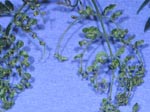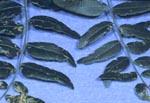Honeylocust Plant Bug
Diaphnocoris chlorionis
Description
The honeylocust plant bug is approximately 1/8 inch long when full grown. It is a pale to light green with a four segmented antennae and a beak-like mouthpart. The nymph is a miniature representation of the adult. Both stages are quite active and will fly when disturbed. The eggs are approximately 1/8 inch long and light in color.
Back to Top
Life History
The honeylocust plant bug overwinters as an egg. The eggs hatch just after the vegetative buds of the honeylocust begin to open. Young nymphs beginning feeding with the most serious damage occurring at this time. Feeding by the nymphs causes a death of leaf cells particularly on the immature leaves. Nymphal development requires approximately 30 days with adult appearing by late May and early June. Eggs are laid by the adults in linear clusters under the bark of 2 and 3-year old twigs. The eggs then overwinter. There is one generation per year and the adults usually disappear by mid to late July.
Damage

Figure 1. Honeylocust
Plant Bug Damage
Feeding by the honeylocust plant bug causes a death of leaf cells on immature growth resulting in severe leaf distortion, dwarfed leaflets, chlorosis, and yellow to brown spots. Irregular holes may result when dead or necrotic tissue falls out of affect leaves. Heavy plant bug populations may cause premature leaf drop while light to moderately damaged foliage may persist throughout the growing season.

Figure 2. Honeylocust
Plant Bug Damage
Nonchemical Control
None known.
Chemical Control
If populations are heavy, foliar sprays may be applied as soon as plant bug feeding is observed.